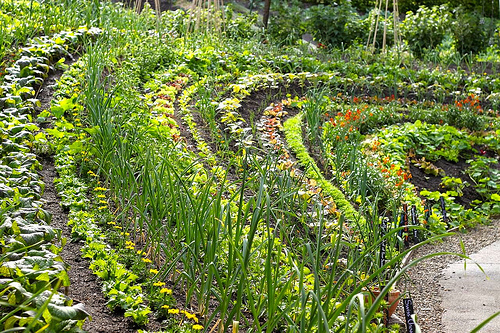
A gardening concept that carries clearly from the garden and greenhouse all the way to the table is the practice of companion plantings. With a little thought, it’s easy to plant the ingredients for future meals that not only compliment each other beautifully on the plate but work well together in the soil.
Companion plantings can work in several ways, and some of the methods are based on hard evidence, while others are gardening traditions, handed down through time. Sometimes the partnered plants attract beneficial insects or repel harmful insects, both of which can decrease the use of pesticides. Some crops enrich the soil, while some light-loving plants provide shade for other plants. The historical grower’s faith in these gardening methods is evident simply by looking at emblematic crops in different areas of the world. Enough Native American tribes grew the “three sisters” crops- corn, pole beans and squash, that the term is central to the sustainable food movement as well as to companion methods of gardening. Additionally, this combination of ingredients suggests immediately recipes that are still in use, including succotash (from the Narragannsett word msíckquatash). Bean plants fix nitrogen into the soil, which corn uses heavily, and the beans and squash are climbers that like to cling to other plants, and the tall corn protects the beans and corn from the hottest rays of the sun. Varieties planted with harvest schedules in mind can also compress the harvest schedule and diversify the yield.
All season companion plantings are great, but summer’s harvest is really an exciting time of year for combined harvests. Another great benefit of growing things that taste good together and grow at the same time is the ease with which they assemble themselves into meals. The fresh tastes of summer means vegetables really need a minimum of treatment to taste special. Even if the plants do not interact in a way that causes tastier fruit or leaves, the freshness and flavors all combine for a truly satisfying food experience.
Lettuce, carrot, radish, and cucumber all grow well together, which sounds like an outstanding salad, especially if bordered by green onions for a fresh vinaigrette dressing. A basic vinaigrette can be made with one part olive oil, one part vinegar of your choice and fresh herbs to taste, and a little honey if needed. Some gardeners swear that growing radishes near lettuce improves the lettuce flavor and pairing lettuce, and radishes makes a refreshing garnish for summertime tacos.
Onions can be a great tool in garden pest management, as they distract or deter aphids and carrot flies, among other pests. However, they don’t plant well with beans, peas, or parsley. They do well with many other plants, including squash. Slice onions into rings, and sautee in butter, then add sliced squash and sautee until the squash is softened. Served as a side dish or over pasta with salt and pepper and maybe some parmesan cheese creates another fantastic summer flavor.
Onions also benefit tomato plants, which in turn grow well with other nightshades, including peppers. Both peppers and tomatoes benefit from basil, which can repel or distract mosquitoes and flies, and is said to improve the flavor of tomatoes. Once again, whether this happens in the garden or in the kitchen may be a toss up, but there’s no denying the delicious flavor combination. A bountiful harvest can leave the gardener with frozen summer pasta sauce well into winter. Fresh, however, all one really must do, yet again, is sautee tomato and peppers with minced garlic in olive oil and/or butter and top with shredded basil and fresh grated parmesan, served on pasta. Tomatoes and peppers can be sliced while pasta cooks; making this a super fast dinner perfect for the summer- these delicious crops really don’t need a whole lot of heating, saving everyone time as well as a little bit of money on the air conditioning. Oregano is another herb that grows well with this little companion family and can be used to give this same recipe a slightly different flavor.
It’s interesting to look at recipes with this knowledge in mind and understand that their basis is not only in what tastes good together, but what grows well together. The history of this practice is certainly responsible for many of the food combinations we enjoy today.
Amy Ambrosius is a writer and budding gardener living deep in the heart of Texas with her family.
Related Articles & Free Email Newsletter Sign Up
7 Reasons for Companion Planting
Simple Steps for Better Weed Control in the Garden
Three Sisters Planting: A Concept in Edible Gardening




Comment here